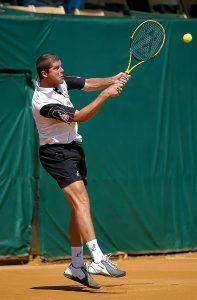We may earn money or products from the companies mentioned in this post.
Introduction

Tennis, a sport enjoyed by millions worldwide, is known for its fast-paced gameplay and strategic maneuvers Whether you’re a player stepping onto the court or a spectator watching from the stands, understanding the rules of tennis is essential to fully appreciate and engage with the game
Tennis has gained immense popularity across different cultures and countries, with tournaments like Wimbledon, the Australian Open, and the US Open drawing in large audiences The sport’s global appeal stems from its thrilling matches, fierce rivalries, and the athleticism displayed by players on both grass and hard courts
For players, having a solid grasp of tennis rules is crucial as it ensures fair play, minimizes disputes during matches, and allows for effective decision-making on the court Spectators also benefit from understanding these rules as it enables them to follow along with the action more easily and appreciate the skillful techniques employed by professional players
Definition and Explanation of a Net Ball in Tennis

In the exciting world of tennis, a net ball is a term that every player should be familiar with So, what exactly is a net ball? Let’s dive into the basic definition and explore its significance within the game
Differentiating Between a Net Ball, Let, and Fault
Before we delve deeper into net balls, it’s essential to understand how they differ from other terms commonly used in tennis A net ball occurs when the ball hits the net before landing in the opponent’s court It is distinct from a let, which refers to instances where the serve touches the net but still lands within the correct service box without hindering play On the other hand, a fault happens when a player fails to execute a proper serve by landing outside their opponent’s service box
When Does a Net Ball Occur During Play?
A net ball can occur both during serving situations and rallies throughout the match Let’s take a closer look at each scenario:
Serving Situations Leading to a Net Ball
-
Ball hitting the net cord or tape before landing in the service box:
Sometimes, during serves, players may find themselves hitting the net cord or tape before their shot reaches its intended destination – inside their opponent’s service box This occurrence results in what we call a net ball -
Consequences for the server after hitting a net ball during their serve:
When it comes to serving, hitting a net ball carries specific consequences for players They are granted an opportunity for a second serve if they hit one during their initial attempt However, if they hit multiple consecutive net balls on their first serve or fail to land the second serve in the correct service box, they may face a loss of point
Net Balls Occurring During Rallies
During intense rallies between players, it is not uncommon for net balls to occur These happen when a player’s shot hits the net before landing in their opponent’s court While unintentional, this occurrence can impact gameplay and scoring
Ultimately, understanding the definition and significance of a net ball is crucial for tennis players It helps ensure fair play and enables players to adapt their strategies accordingly So next time you hit that perfect shot, make sure it clears the net without any mishaps!
Strategies to Avoid Hitting Net Balls During Gameplay

Tennis is a game of precision and finesse, where every shot counts One of the most frustrating moments on the court is when your ball hits the net, robbing you of a potential point To prevent this from happening, here are some strategies you can employ to improve your accuracy and avoid those pesky net balls
Techniques for Improving Serve Accuracy
Your serve sets the tone for the entire game, so it’s crucial to make it count To improve your serve accuracy:
- Adjust your body position and stance: Make sure you have a solid base by positioning your feet shoulder-width apart and pointing them towards the net This will help maintain balance and generate power
- Select the proper grip: Experiment with different grip styles to find one that suits you best A continental or Eastern grip is commonly used for serves as they provide better control and maximize racket-head acceleration
- Build consistency through practice: Practice makes perfect! Dedicate time to honing your serve technique regularly Focus on maintaining a fluid motion and hitting the sweet spot of your racket consistently
Adapting Playing Style Based on Opponent’s Strengths/Weaknesses
No two opponents are exactly alike, so it’s important to adapt your playing style accordingly By analyzing their strengths and weaknesses:
- Recognize patterns in competitor’s play: Pay attention to how your opponent moves around the court, their preferred shots, and any predictable patterns they follow This knowledge will give you an advantage in anticipating their shots
- Utilize shots that minimize chances of hitting the net: When facing an opponent who excels at net play, consider employing lobs or ground-strokes that keep the ball low and force them to move back This reduces the likelihood of hitting the net and puts pressure on your opponent
Incorporating Drills into Practice Sessions to Build Skill Mastery
Consistent practice is key to becoming a skilled tennis player Incorporate drills into your practice sessions to improve your overall skill level:
- Focus on accuracy: Set up targets on the court and aim for them with each shot, whether it’s serves, ground-strokes, or volleys This will train your hand-eye coordination and help you develop better control over the ball
- Vary shot placement: Practice hitting shots from different areas of the court, including near the net and baseline By diversifying your shot selection, you’ll become more comfortable in various situations and reduce the chances of hitting the net
- Simulate match scenarios: Create game-like situations during practice sessions by playing practice matches or setting specific goals for yourself This will help you handle pressure situations better and make accurate shots consistently
By incorporating these strategies into your training routine, you’ll be able to avoid hitting net balls during gameplay, improving your overall performance on the tennis court
Frequently Asked Questions about Net Balls

What happens if you hit two consecutive serves into the net?
When a player hits two consecutive serves into the net, it is called a double fault In tennis, a double fault results in the loss of a point for the serving player It can be frustrating for players as it not only costs them a point but also gives their opponent an advantage in the game
Is it legal to touch the net during play?
According to the rules of tennis, players are not allowed to touch the net during play Touching or hitting the net with any part of their body or racket results in a violation and leads to losing a point The rule is in place to ensure fair play and prevent players from gaining an unfair advantage by interfering with the net
Can you win points by deliberately aiming at your opponents’ side of the court?
In tennis, deliberately aiming at your opponents’ side of the court is considered acceptable strategy rather than gamesmanship Players often use different tactics and shot placements to exploit their opponent’s weaknesses or create opportunities for themselves As long as these shots are within the boundaries of fair play and follow all other rules, they can result in winning points
How is a net ball different than a let?
A net ball and a let are two different situations in tennis A let occurs when there is interference during play that hinders either player’s ability to make a proper return In such cases, the point is replayed without any penalty On the other hand, a net ball refers specifically to when the ball touches or grazes the top of the net but still lands within bounds on your opponent’s side In this case, play continues normally, and the point is not replayed
What if a net ball occurs during a tiebreak situation?
During a tiebreak in tennis, net balls are handled in the same way as regular play If the ball touches or grazes the net but still lands within bounds on your opponent’s side, it is considered a valid shot, and play continues without any interruption or replay of the point The pressure of a tiebreak situation adds to the intensity of the game, but players must adhere to the same rules regarding net balls as in any other part of the match
Useful Links

Why in tennis, when the tennis ball hits the net, is it called ‘ …
Rules of Tennis | Wanless Park Tennis
Can The Ball Hit The Net In Tennis? A Simple Answer For …
Tennis Serving Rules | USTA
Netball….What is Netball? – Munson, Inc.
Can the Ball Hit the Net in Tennis? (6 Scenarios Explained)
ITF – Rules of Tennis – Uberflip
Tennis: Glossary of terms and definitions
Tennis Rules Explained – The Basics of Tennis
net ball in tennis Crossword Clue
Breaking The Rules: Time to abandon the net touch?
Can You Reach Over the Net in Tennis? – Dan’s Advantage
How To Play Tennis | Rules of Sport
Furlihong NT01 Baseball & Tennis Ball Recycling System …
NET BALL
Frequently Asked Questions About Ping Pong






